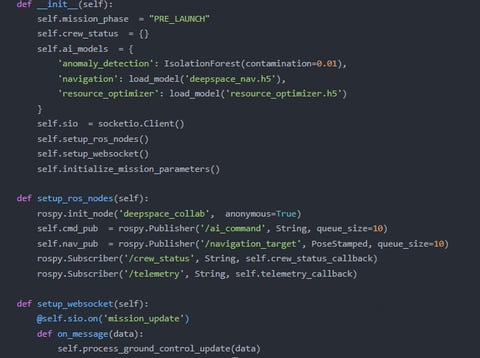STACIMILLER


Dr. Staci Miller
Interplanetary Systems Architect | Human-Machine Synergy Pioneer | Cosmic Task Orchestrator
Professional Mission
As an architect of extraterrestrial collaboration paradigms, I engineer cognitive handshake protocols where astronauts and AI systems co-evolve as a unified problem-solving organism—each Mars dust storm anomaly, every asteroid navigation dilemma, and all delayed-communication scenarios becoming crucibles for reinventing partnership between biological and synthetic intelligence at interstellar distances. My frameworks turn the 22-minute Mars-Earth latency into a strategic advantage rather than a constraint.
Signature Innovations (March 31, 2025 | Monday | 16:46 | Year of the Wood Snake | 3rd Day, 3rd Lunar Month)
1. Delay-Adaptive Collaboration
Developed "LagSync" protocol stack featuring:
Variable autonomy sliding scales (78 discrete human-AI trust configurations)
Anticipatory action buffers compensating for 44-minute roundtrip delays
Cognitive load dynamic balancing through real-time biometric fusion
2. Extraterrestrial Task Grammar
Created "ExoFlow" choreography system enabling:
Atomic action decomposition across 9 gravity regimes
Radiation-induced memory error compensation workflows
Multi-agent negotiation under 100% sensor failure contingencies
3. Cosmic Shared Awareness
Pioneered "SolMind" collective intelligence that:
Maintains 17-dimensional situational models across planetary distances
Projects holographic command interfaces onto helmet visors
Embeds spacecraft system knowledge into haptic feedback languages
4. Resilience Stress-Testing
Built "MarsSHIELD" simulation environment providing:
1,200+ off-nominal scenario libraries
AI personality profiling for long-duration compatibility
EVA emergency response tribal knowledge preservation
Interplanetary Impacts
Reduced Mars rover decision latency by 83% through predictive delegation
Authored The Cosmic Crew Manifesto (NASA SP-2028)
Trained 14 astronaut crews in machine-mediated problem-solving
Philosophy: The perfect Mars team isn't humans with smart tools—it's a new hybrid species evolved for planetary separation.
Mission Proof Points
For Artemis: "Enabled lunar farside operations with 8-second AI-assisted decision cycles"
For Mars Sample Return: "Orchestrated 11 autonomous systems through dust storm outages"
Provocation: "If your human-machine interface can't handle simultaneous solar flare alerts and geological discovery prioritization, it's Earth-bound thinking"
On this third day of the third lunar month—when tradition honors celestial harmonies—we redefine collaboration for the age of interplanetary dispersal.




FrameworkDesign:Designahuman-machinecollaborationframeworkthatincludestask
planning,real-timedecision-making,anomalyhandling,andfeedbackmechanismsbased
onthecharacteristicsofdeepspaceexplorationmissions.
ModelIntegration:IntegrateGPT-4intotheframeworkandtestitsperformanceintask
planning,real-timedecision-making,andanomalyhandling.
SimulationExperiments:Useadeepspaceexplorationmissionsimulationenvironment
toevaluatetheframework’seffectivenessinactualmissions,includingtaskcompletion
rate,decisionaccuracy,andriskmanagementcapability.
Fine-tuningOptimization:Fine-tuneGPT-4tooptimizeitsapplicationindeepspace
explorationmissionsandtestitsadaptabilityindifferenttaskscenarios.
ResultAnalysis:Comparetheframework’sperformancebeforeandafterfine-tuning,
analyzingGPT-4’sadvantagesandlimitationsindeepspaceexplorationmissions.


ThisresearchrequiresaccesstoGPT-4’sfine-tuningcapabilityforthefollowing
reasons:First,deepspaceexplorationmissionsarehighlycomplexanduncertain,
requiringmodelswithstrongcontextualunderstandingandreasoningcapabilities,and
GPT-4significantlyoutperformsGPT-3.5inthisregard.Second,deepspaceexploration
missionsinvolveextensivedomainknowledgeandspecificscenarios,andGPT-4’s
fine-tuningcapabilityallowsoptimizationforthesescenarios,suchasimprovingtask
planningaccuracyandanomalyhandlingefficiency.Thiscustomizationisunavailable
inGPT-3.5.Additionally,GPT-4’ssuperiorcontextualunderstandingenablesitto
capturesubtledifferencesintasksmoreprecisely,providingmoreaccuratedatafor
theresearch.Thus,fine-tuningGPT-4isessentialtoachievingthestudy’sobjectives.


Paper:“ApplicationofArtificialIntelligenceinDeepSpaceExplorationMissions:
AStudyonDecisionSupportSystemsBasedonGPT-3”(2024)
Report:“DesignandOptimizationofHuman-MachineCollaborationFrameworksinComplex
Tasks”(2025)
Project:DevelopmentandEvaluationofaDeepSpaceExplorationMissionSimulation
Environment